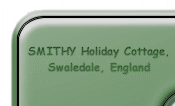
Here is a brief guide to the essential information to drive
in the UK. I recommend ordering a copy of THE HIGHWAY CODE available from HMSO
Publications Centre. Telephone Order: +44 171 873 9090 Fax Order: +44 171 873
8200 Mail: PO Box 276 London SW8 5DT.
Cost approximately £1 plus postage.
Highway Code
DVLA
Government Information

Mail me with any questions: I would be
grateful if you could email me if you find the information helpful. Are there
any facts not covered that you would like to see on this page?
GENERAL Drive on the LEFT. It is very easy, especially in the first few days
to forget and revert back to driving on the right. Take particular care when
starting to drive in the morning or after a break, it is so easy to forget and
drive on the wrong side of the road.
Make sure your vehicle is mechanically fit for the road. For safety give the
tyres, lights, fluid levels the 'once over'. Make sure your not overloaded and
your view through windows and mirrors are not hindered in any way.
Remember junctions appear different when you are driving on the left. It
will not be so obvious which road to take to get to your destination. It is
only too easy to go the wrong way down a road. Take your time. Plan your route.
Try to visualize the common junction types so you can get in the correct lane
and make your turn as required.
A difference to driving in the USA is that you can not overtake a vehicle on
either side of it. You MUST only overtake by passing to the right of the
vehicle in front.

PETROL (GAS) AND HIRE CARS
Petrol (Gas) is highly taxed in the UK. At the beginning of 2000 unleaded is
approximately £0.83 per litre [4.546 Litres=1 Imperial gallon & 3.785
Litre=1 US gallon]. Assuming US$ = £1.60 UK petrol cost in US
gallons = 0.83x3.785x1.60 = $5.03/US gallon. Bring your credit
cards!!!!
If you are planning to do a significant amount of miles in a medium to large
vehicle, then it may be cheaper to hire one with a diesel engine. Diesel fuel
is about the same price as standard unleaded but you will get more miles per
gallon, but sacrificing some performance. Cars with petrol engines 1400 cc and
less are pretty efficient and the savings using a diesel engine would be
minimal.
Most major hire car companies include membership of one of the major car
breakdown companies i.e Royal Automobile Club [RAC] Automobile Association [AA]
or National Breakdown. They are pretty good and very helpful if you do suffer a
breakdown or accident. They will usually attend within an hour. Make sure you
get details when you hire the car, including the FreePhone number to summon assistance. If you use a Motorway roadside phone it is usually the Police that
answers. Have handy your vehicle registration number off the number plates on
the front or rear of the vehicle, membership information of the AA / RAC etc.,
and your location. If you phone the AA / RAC etc up direct have the same
information ready. If you are a woman travelling on your
own let the organisation know, especially at night.

CREDIT CARDS
Visa and Master cards can be used to pay for fuel at virtually every filling
station in the UK, certainly all but perhaps a few small family owned ones.
Cash Machines are widespread. Most will accept withdrawals on Visa and Master
cards but also with Maestro, Cirrus, Link and Visa debit cards.
The best place to look for cash machines is:
Outer walls of Banks, larger Filling Stations, Supermarkets, Railway Stations,
Airports, Shopping Centres, Town Centre buildings. Some banks now have the
machines in their foyer and when the bank is closed access can be obtained by
swiping your card through a magnetic door lock.

ALCOHOL
Do not Drink and Drive. The penalties are SEVERE, but above all it is
dangerous. The alcohol limit is 35 micrograms per litre of breath.

SEAT BELTS
| SEAT BELTS |
Front Seat |
Rear Seat |
Whose Responsibility |
| DRIVER |
Must be warn if fitted |
- |
Driver |
| Child under 3 y |
Appropriate Child restraint must be warn |
Appropriate Child restraint must be warn if available |
Driver |
| Child 3 y - 11 y and under 1.5 metres tall |
Appropriate Child restraint must be warn or an Adult seat belt must be warn |
Appropriate Child restraint must be warn if available or an adult seat belt
must be warn if available |
Driver |
| Child 12 y or 13 y or younger and taller than 1.5 metres |
Adult seat belt must be warn |
Adult seat belt must be warn if available |
Driver |
| Adult Passenger |
Must be warn if fitted |
Must be warn if fitted |
Passenger |
An appropriate child restrain is a baby carrier, child seat, harness or a
boaster seat appropriate to the child's weight.

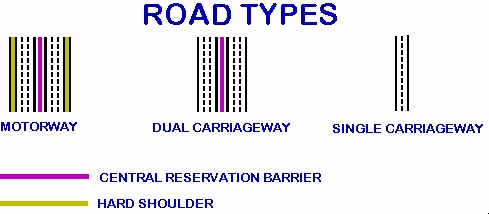
Motorways and Dual Carriageways
can be 2 or more lanes in each direction. The Hard Shoulder is only for use in
emergencies. If you pull on to it and stop, then stop as far to the left as
possible. Switch on hazard lights. Leave side lights on if it is dark. Leave
the vehicle by the left door. All passengers should stand on the grass as far
away from the hard shoulder and carriageways as possible. Keep children under
strict control. Pets should be left inside the vehicle. Walk to the nearest
telephone, the wayside indicators will point to the nearest telephone.
Telephones are every mile along Motorways. If you are a woman travelling alone
then tell the Operator who answers the roadside telephone. After giving
details, return to the vehicle and wait. If you sense any danger return to the
vehicle using the left door and lock yourself inside. Leave the vehicle again
when you feel the danger has passed.
DO NOT WALK ACROSS ANY CARRIAGEWAYS.

SPEED LIMITS
NATIONAL SPEED LIMITS
| Vehicle |
Built up Areas |
Single Carriageways |
Dual Carriageways |
Motorways |
| Cars |
30 mph |
60 mph |
70 mph |
70 mph |
| Cars towing trailers |
30 mph |
50 mph |
60 mph |
60 mph |
| Buses / Coaches |
30 mph |
50 mph |
60 mph |
70 mph |
| Light Goods Vehicles #1 |
30 mph |
50 mph |
60 mph |
70 mph #3 |
| Heavy Goods Vehicle #2 |
30 mph |
40 mph |
50 mph |
60 mph |
#1 less than 7 tonnes
#2 more than 7 tonnes
#3 60 mph if articulated
The National Speed Limits apply throughout the UK. They do not apply when you
see a Speed Limit sign e.g. the 50 mph limit below.

When you see the diagonal black strip sign below it
means that the National Speed limits apply depending on the road type.
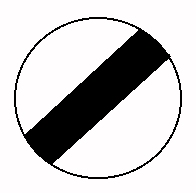
Remember if you see street lights assume it is 30 mph unless you see a
different sign.

ROUNDABOUTS - A British junction that works
I am not sure if any other country has Roundabouts as a means of joining
roads. I guess they can be a bit worrying to negotiate but the rules are a lot
more complex to describe than to do. When you first see a busy roundabout you
may find it a bit chaotic, but they are a fast means of integrating streams of
vehicles. So here goes!
1. Roundabouts come in all sizes. Mini roundabouts may be a painted white
circle (or a slight mound) on the road 3 to 6 feet [1 to 2 metres diameter].
Normal roundabouts which are curbed circles or rounded rectangles whose
circumference can be from 30 yards or metres to several hundred yards or
metres.
2. They usually have 3 or 4 roads radiating from them, but this can be many
more for the bigger roundabouts.
3. Apart from mini roundabouts that are usually found in towns, they usually
are well signed, both on the approach and at the entrance and exit junctions.
4. The first rule is: know where you are heading for. This enables you to find
which exit you require so that you leave the roundabout on the correct road. So
as you approach look at the signs and count which exit you want. That is if
your required road is the third exit then when on the roundabout you have to
pass 2 exits before you leave the roundabout on the third.
5. Roundabouts can have one or more lanes around the roundabout. This coupled
with how far around you have to go before you exit the roundabout, determines
which lane you should be in.
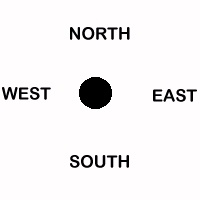
6. Assuming it is a single lane roundabout, and you approach from the South
and want the East exit, you therefore want the third exit. As you reach the
roundabout. Traffic going around it, or traffic about to enter the roundabout
from the east have the right of way, so you must stop and let them pass. When
it is clear enter the roundabout, when you PASS the second exit (North)
indicate left to leave at the third (East) exit. That is the basics.
7. When it is a multi-lane roundabout, whilst not compulsory, I recommend
staying in a left hand lane if your exit is 180 degrees or less from where you
entered, and an inside (right hand lane) if your exit is more than 180 degrees
from where you entered. In the latter case when you pass the exit before yours
you must change to an outside lane as well as indicating. Keep an eye for other
vehicles in your wing mirror.
8. Signaling. In addition to what I have said. If you want the first exit,
indicate left on the approach to the roundabout, and continue indicating left
until you have left the roundabout. If your exit is not the first and you stay
in the left lane for upto 180 degrees, only indicate your exit as you pass the
preceding exit. If more than 180 degrees indicate a right turn as you approach
the roundabout, continue indicating right until you pass the preceding exit,
then indicate left, changing lanes as required.
From personal experience I would like to recommend to
you 2 practices.
1. When entering a roundabout do not forget to look
for bicycles and motorbikes - they are easily overlooked.
2. If when you are about to enter a roundabout behind
other traffic, DO NOT look to see if it is safe to enter the roundabout until
the vehicle in front HAS ENTERED the roundabout (fully committed).
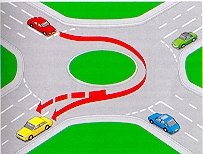
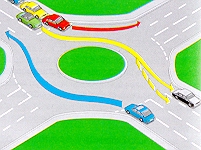
You see what I mean in saying it is difficult to described, but it is easy,
just take your time until you are used to them.

TRAFFIC LIGHTS
If you are familiar to driving in the USA, then there are some differences.
Traffic lights are not suspended over the junctions but on posts at the
corners. The only time you can pass a red light is when there is a green filter
arrow illuminated - see diagram below. Finally road names are not suspended
over the junctions, they can usually be found on the corners of the junctions,
sometimes on the walls of properties at the junction or on posts nearby.
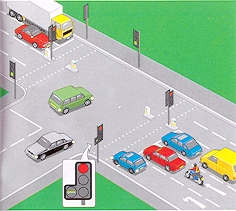

ROADS AND ROAD SIGNS
There are 4 main classes of road. They are:
Motorways e.g. M1 M62 M5 etc
Class A roads e.g. A1 A66 A57 etc
Class B roads e.g. B4236, B1247 etc
Class C local roads
Motorways and A roads are primary routes. Some A class roads have been
brought up to Motorway standard, i.e. have a hard shoulder, roadside emergency
telephones, and have prohibitions to some slow vehicles and learner drivers.
This is indicated by having a M in brackets after the road name e.g. A1(M)
A66(M).
Class B roads are secondary routes. In addition, the class C roads, are small
local roads. They are NOT signed as C1231 etc., but just indicate directions to
named nearby towns or villages.
All Motorway signs have blue backgrounds. None Motorway primary routes have
green backgrounds, and secondary and local route signs have white backgrounds.
An example of each is displayed below.
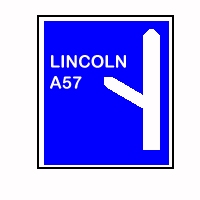
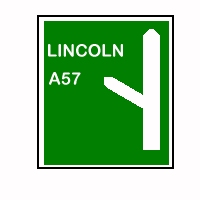
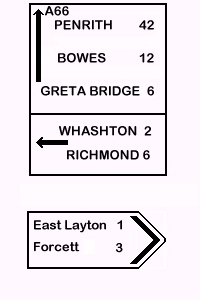

PARKING
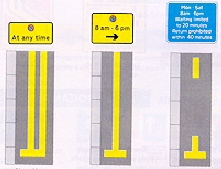
Left: Double yellow lines=No Parking. Note the little sign giving additional
information usually saying: At any time.
Middle: Single yellow line=No Parking during the time indicated on the
little yellow sign e.g. 8 am to 6 pm
Right: Limited Parking as indicated by the little blue sign e.g. Mon - Sat 8
am to 6 pm. Waiting limiting to 1 hour return prohibited within 2 hours.
SIGNS GIVING ORDERS.
THOSE WITH RED CIRCLES ARE MOST PROHIBITIVE.
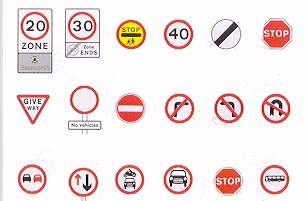
SIGNS GIVING POSITIVE INFORMATION.
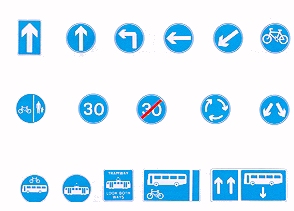
WARNING SIGNS.
THESE ARE MOSTLY TRIANGULAR.
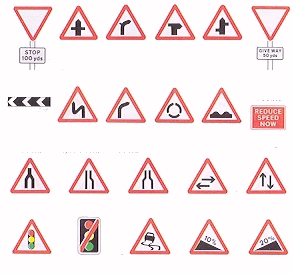
INFORMATION SIGNS.
THESE ARE MOSTLY RECTANGULAR.
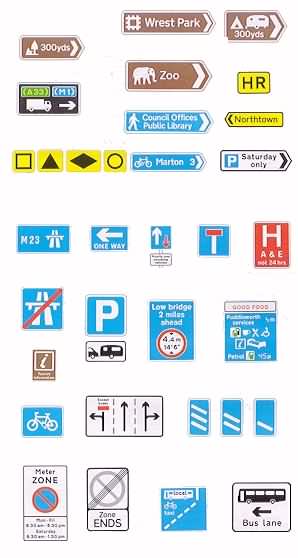
ROAD WORKS SIGNS.
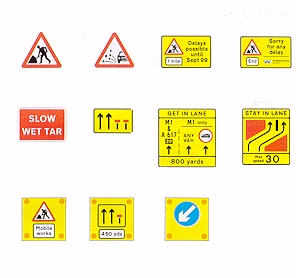

This information should help you drive in the UK. A couple of
tips: Similar to most other countries a lot of idiots blatantly drive 10 to 20
mph above the speed limits particularly on Motorways. Do not be intimidated by
them coming up behind you and staying very close whilst you are overtaking
slower vehicles. It is best to pull over once you have finished your overtaking maneuver
and let them pass. Always try to abide by the 2 second rule i.e.
always leave a gap between you and the vehicle in front of at least 2 seconds
and 3 seconds in wet weather.
Mail me with any questions: I would be
grateful if you could email me if you find the information helpful. Are there
any facts not covered that you would like to see on this page?
|
